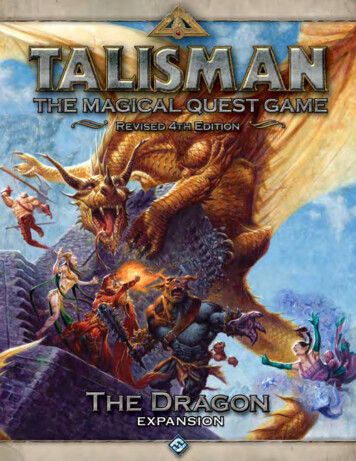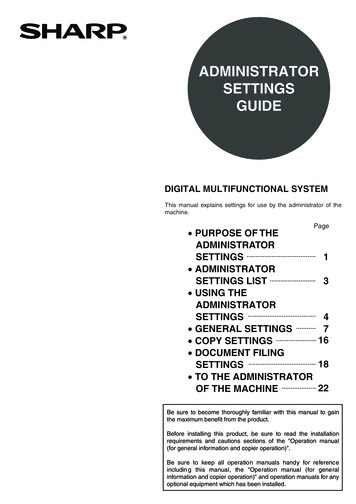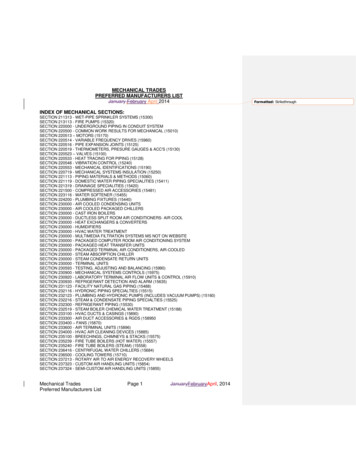
Transcription
Expansion OverviewLegend of theDragon KingThree Draconic Lords, beings of near infinite power andmalevolence, have returned to the Firelands to claim thefabled Crown of Command. With them come legions of evildragons, harnessing the awesome powers of their darkmasters. Now the land quakes beneath their oppressive rule,and the quest for the Crown is more terrifying and dangerousthan ever before!Hundreds of years ago, a mighty wizard daredto assail the Dragon Tower in the Firelands.Once there, he used powerful spells to banishthe Dragon King into a horrible black void andthen drove the remaining Draconic Lords intohiding far away. Only then was the wizardfree to enter the Valley of Fire, a scorched landwhere arcane fires burn continuously. For thedragons, this was the source of heat thatkept the eggs in their hatchery warm, but thewizard had other plans.The Dragon is an epic level expansion, forcing the charactersto confront fearsome dragons and deadly challenges throughout the game. Players draw dragon tokens at the start of theirturns which commonly results in placing a dragon scale onone of the Draconic Lords. When a Draconic Lord accumulatesthree dragon scales, he becomes the new Dragon King andone of his dragon scales is placed on the game board. Characters encountering a dragon scale on a space on the boardmust draw a Dragon Card instead of drawing from the regularAdventure deck. Characters may claim the dragon scale ontheir space if they kill an Enemy from a Dragon Card. Eachdragon scale a character claims increases his fighting prowessagainst the Draconic Lords and their minions. When a character builds up enough power and courage, he must reach theCrown of Command in the Inner Region and vanquish theDragon King to win the game!The wizard cruelly enslaved spirits who couldharness the Valley of Fire’s mystical flames andforged the mighty Crown of Command. Withthis powerful artefact, he ruled over the landfor the rest of his life. When at last the wizardpassed away, he hid the Crown of Commandwithin the shattered ruins of the DragonTower, waiting for a champion strong enough,brave enough, and clever enough to claim thepowerful artefact and become the new ruler ofthe realm.Object of the GameThe object of the game is to reach the Crown of Command inthe centre of the board and vanquish the Dragon King (see“Confronting the Dragon King” on page 14).But the dragons have not forgotten that theFirelands were once their domain. And there arelegends that the dragons will return.Hidden away in shadowy temples, diabolicalDragon Cults teach that the Draconic Lordswill return and that one of them will claim theCrown of Command for himself to become thenew Dragon King. When the new Dragon Kingis crowned, it shall herald an era of terror andflame in which only the most devoted servantswill be spared.Recent dark omens lead some to believethat dreadful time may now be at hand. Fortravellers have seen wyverns and drakescloser to towns, and the silhouettes of largercreatures have been spotted overhead flying toand from the Firelands. There, the dragons toilceaselessly to rebuild the Dragon Tower, makingit an impenetrable fortress.Now, for those brave adventurers who seek theCrown of Command, the quest is more thanjust a bid to gain power and influence. It is arace to save the land from the Dragon King’styrannical rule!2
ComponentsComponent Overview This RulebookBoard OverlayThe Dragon expansion includes the following components:Below is a brief description of each game component. 1 Double-sided Board OverlayThe board overlay is placed on themain game board and replaces theInner Region with new encountersand victory objectives. The DragonRealm is featured on one side andthe Dragon Tower is featured onthe other side. Before starting thegame, players must decide whichside to use. 168 Dragon Cards, consisting of:»» 56 Varthrax Cards»» 56 Cadorus Cards»» 56 Grilipus Cards 3 Alternative Ending CardsDragon Cards 3 Draconic Lord Cards, consisting of:»» 1 Varthrax Draconic Lord CardDragon RealmDragon TowerThe 168 Dragon Cards are separated into Varthrax, Cadorus,and Grilipus decks. Each deck of 56 cards features newEvents, Enemies, Strangers, Objects, Followers, and Places.Dragon Cards are similar to Adventure Cards, but are encountered by characters exploring spaces occupied by one of theDraconic Lords’ dragon scales.»» 1 Cadorus Draconic Lord Card»» 1 Grilipus Draconic Lord Card 140 Dragon Tokens, consisting of:»» 40 Varthrax Dragon Scales»» 40 Cadorus Dragon Scales»» 40 Grilipus Dragon Scales»» 6 Dragon StrikesVarthrax deckCadorus deckGrilipus deck»» 6 Dragon RagesAlternative Ending Cards»» 8 Dragon Slumbers 1 Crown TokenThe use of the three newAlternative Ending Cards isoptional, and players mustagree whether or not to usethem before starting the game(see “Alternative EndingCards” on page 15). 19 Sleep Tokens 6 Character Cards 6 Plastic Character FiguresDraconic Lord CardsThe Dragon SymbolThe three Draconic Lords(Varthrax, Cadorus, and Grilipus) represent the contendersfor the Crown of Command.When a Draconic Lord seizescontrol of the Crown, hebecomes the Dragon King fora time, until another DraconicLord usurps him and becomesthe next Dragon King.Cards in The Dragon expansion are markedwith an expansion symbol to differentiatethem from the cards in the base game.3
Dragon TokensThe 140 dragon tokens representthe Draconic Lords’ dominanceover the land. When a DraconicLord has accumulated threedragon scales on his card, hebecomes the next Dragon King!Using OnlyPortions ofThis ExpansionCrown TokenOvercoming the dangers and perils of theboard overlay and vanquishing the DragonKing is the greatest challenge for even themightiest hero. While The Dragon expansionis intended to be used in its entirety as an epicquest for the Crown of Command, players arewelcome to play Talisman using only someof the elements of the expansion in order tospeed the game up or reduce the difficulty ofthe victory condition. The new characters andAlternative Ending Cards may be used withoutincluding the new tokens, cards, or boardoverlay. Players may also use the new DragonCards and Draconic Lord Cards without theadditional challenge of the board overlay. Seethe “Optional Rules” section on page 16 formore details.The Crown token is placed on one of theDraconic Lords to indicate the currentDragon King. When another DraconicLord accumulates three dragon scales, heseizes the Crown and becomes the currentDragon King.Sleep TokensThe 19 Sleep tokens may be placed onDragons during the course of the game bycertain encounters and effects. A sleeping Dragon has its fighting capabilitiesreduced but will wake up at the end of anattack if a character does not defeat it.Character CardsThe six new charactercards work exactly likethose in the base game,and offer players an evenlarger selection of heroesto play.Using theDragonwith OtherExpansionsCharacter FiguresEach of the new characters has a plastic figure used to represent that hero on the game board.The Dragon expansion can be used withany Talisman expansion, including boardsthat offer new Regions to explore such as theDungeon and Highland. Characters may enterthese Regions regardless of what tokens orcards from The Dragon expansion are placedon their entrance spaces.4
Setup3. Set Up Dragon Decks: Separate the Dragon Cards bycolour into three decks (the Varthrax deck is red, theCadorus deck is gold, and the Grilipus deck is green).Shuffle each deck individually and place it facedown besideits matching Draconic Lord Card.When playing with The Dragon expansion, add the followingsteps after the base game’s setup is completed:1. Place Board Overlay: Players must agree which side ofthe board overlay to use. If players are using The Dragonexpansion for the first time, we recommend using theDragon Realm side until they are more experienced withthe game. The board overlay must be placed over the InnerRegion on the main game board so the doorways of thePortal of Power on both boards line up correctly.4. Set Up Dragon Tokens: Place all of the dragon tokensfacedown next to the game board and randomize them.Players may prefer to place them in the box lid or a bowlinstead. This forms a pool of dragon tokens.5. Place Sleep Tokens: Place all of the sleep tokens next tothe game board. This forms a pool of sleep tokens.2. Set Up Draconic Lord Cards: Shuffle the three DraconicLord Cards facedown and place them next to the gameboard. Reveal one Draconic Lord at random by flipping thecard faceup and place the Crown token on the card. Flipthe other two Draconic Lord Cards faceup. Then place fivelife counters on each of the Draconic Lord Cards.After these steps have been carried out, the game is ready tobegin!Setup Example4152322335
Expansion RulesThree Draconic Lords are vying for control of the Crown ofCommand. When a dragon seizes control of the Crown, hebecomes the Dragon King and claims dominance over areason the board, represented by one of his dragon scales beingplaced on a space. The reign of the Dragon King is short-lived,however, and only lasts until one of the rival Draconic Lordsgathers enough power to usurp the Crown and become thenew Dragon King. Characters exploring spaces with dragonscales may face challenges from Dragon Cards instead ofencountering the space normally.Matching Tokensand CardsEach dragon scale and Dragon Card matchesone of the three Draconic Lords:These rules are used in addition to those in the main Talisman game when playing with The Dragon expansion.Drawing Dragon TokensAt the start of each player’s turn, he must draw one dragontoken at random from the pool and resolve its effect. After theeffect of the dragon token is resolved, the player continues histurn as normal. The effects of the various dragon tokens fallinto two different types: special effects and dragon scales.Varthrax dragon scales and Varthrax Cardsmatch the Draconic Lord Varthrax.Special EffectsThese tokens are always discarded after their effects havebeen resolved.Dragon StrikeThe character who drew the token immediately draws two additional dragon tokensfrom the pool and resolves them in theorder in which they were drawn. If additional Dragon Strikes are drawn, the character must continue to draw additionaldragon tokens. After the Dragon Strike isresolved, it is discarded.Cadorus dragon scales and Cadorus Cardsmatch the Draconic Lord Cadorus.Dragon StrikeDragon RageThe character who drew the token suffersthe Dragon Rage of the current DragonKing (see “Dragon Rage” on page 15).After the Dragon Rage is resolved, it isdiscarded.Grilipus dragon scales and Grilipus Cardsmatch the Draconic Lord Grilipus.Dragon RageDragon SlumberThe character who drew the token placesa sleep token on one Dragon of his choicein any Region. If there are no Dragonson the board, he may place the token onany Enemy of his choice. If there are noEnemies on the board, the Dragon Slumberhas no effect. After the Dragon Slumber isresolved, it is discarded.Dragon SlumberWhen a character encounters an Enemy with a sleep tokenon it, the Enemy’s Strength and Craft are both reduced by 3points, to a minimum of 1 (see “Sleep Tokens” on page 15).6
Dragon ScalesWhen a dragon scale is first drawn, it is placed on the matching Draconic Lord Card. The number of dragon scales on aDraconic Lord indicates how close he is to becoming the nextDragon King (see “Crowning the Dragon King” on page 8).The effects of dragon scales vary depending on whether theyare placed on a Draconic Lord, the game board, or a character’s play area.When a dragon scale is placed on the game board, charactersmay have to draw Dragon Cards when they encounter it onthe space (see “Encountering Dragon Scales” on page 10).VarthraxDragon ScaleCadorusDragon ScaleWhen a dragon scale is placed in a character’s play area, thecharacter gains a bonus to his attack score for each dragonscale that matches his opponent (see “Claiming DragonScales” on page 11).GrilipusDragon ScaleDragon LoreFrom storm-darkened skies, three Draconic Lords have descended upon the Firelands, their ancestral home,in an attempt to claim the Crown of Command. While all three dragons are mighty and fearsome, each isunique in his abilities and temperaments. The legends of these mythic creatures paint a terrifying picture.VarthraxAn enormous dragon who possesses unthinkable strength and a keen tacticalmind. Those who serve Varthrax thrive on physical combat and typically wieldpowerful weaponry. This Draconic Lord uses his influence to pit dishonouredknights and power-hungry warlords against those who would oppose his rule,particularly the noble knights who dwell within the Castle. Varthrax usuallyfavours honourable victory in fair combat, but when given over to fits of rage, helashes out violently, destroying anything and everything around him.CadorusA cunning and calculating dragon with a vast hoard of gold that he uses to enacthis complex schemes. Those who serve Cadorus excel in amassing great wealthand exerting political and economic influence. He holds especially strong swayamong merchants and nobles who use their fortunes to starve and oppress thesimple country folk of the land. Cadorus particularly despises the humble farmerswho dwell within the Village, whose simple rural lives and agricultural strengthdefy the dragon’s ability to bribe or starve them. Cadorus usually favours guileand subterfuge, but when given over to fits of rage, his boundless greed driveshim to claim as much wealth as he can with no regard to subtlety.GrilipusA mysterious dragon who has mastered the magical art of leeching power fromall living things around him. Those who serve Grilipus use spells and rituals tobend the forces of nature to serve their master’s will. He is particularly adept atmanipulating druids, rangers, and others who are tied to the natural elements.Grilipus finds the priests who dwell within the Temple intolerable and seeks towipe them out for their worship of spirits that dwell within the sky, not the land.Grilipus is usually protective of the environment from which he draws his power,but when given over to fits of rage, his corrupt nature reaches out and poisonseverything around him with death and decay.7
Crowning the Dragon KingWhen a character draws a dragon scale, it is placed on thematching Draconic Lord Card. When the third dragon scaleis placed on a Draconic Lord, he is immediately crowned thenew Dragon King and the Crown token is placed on his cardas a reminder of his status.Character LoreDragon HunterA fierce fortune-seeker who hasperfected the dangerous art oftracking and slaying dragonsto claim their hoards and collectrewards from terrified villagers.The character then takes one dragon scale from the DragonKing’s card and places it on the character’s space. If the spacealready has a dragon scale, it is placed in the next spacecounterclockwise that does not already have a dragon scale.If every space in the Region already has a dragon scale, thedragon scale is discarded and the character must suffer theDragon Rage of the Dragon King instead (see “Dragon Rage”on page 15). The two remaining dragon scales on the DragonKing’s card are discarded, and the character continues histurn as normal.Fire WizardA volatile and frighteningmaster of pyromancy who istorn by the constant strugglebetween his rational pursuitsand the all-consuming rage thatburns inside of him.In this manner, the Dragon King changes throughout thegame and spawns Varthrax, Cadorus, and Grilipus dragonscales on board spaces.Dragon RiderImportant: Characters in the Inner Region do not place adragon scale on their space; all three dragon scales on theDragon King’s card are discarded instead.A fearless and insightfultraveller who, through disciplineand bravery, has uncovered themysteries of taming dragons,turning them from ferociousenemies to loyal companions.Enemy DragonsConjurerA deft and nimble practitioner ofthe magical arts who uses hermiraculous sleight-of-hand toentertain and delight those sheencounters.Some cards and special abilities only affectDragons.Dragon PriestessA domineering and powerhungry matriarch of the DragonCults who can perform ancientrituals and sacrifices to gainboons from the dragons sheworships.MinotaurA brutish creature ofunrestrained violence whocharges forward to crushanything in his path with noregard to the devastation thathe brings.The term “Dragon” refers to any Enemy withthe word “Dragon” in the card type box. Cardsand special abilities that only affect Dragonsdo not affect Draconic Lords or creatures in theInner Region.8
Example of Crowningthe Dragon KingThe Conjurer draws a Varthrax dragon scale at the start of her turn. The dragon scale is placed on theDraconic Lord Varthrax, which brings his total to three dragon scales.This results in Varthrax being crowned the new Dragon King! The Crown token is placed on Varthrax,then the Conjurer takes one dragon scale from Varthrax and places it on her space. The remaining twodragon scales on Varthrax are discarded and the Conjurer continues her turn.9
EncounteringDragon ScalesDuring the course of the game, dragon scales are placed onthe board when Draconic Lords are crowned the Dragon Kingand as a result of various cards. If a character lands in aspace that has a dragon scale, he may either encounter thespace, a character in the space, or the dragon scale in thespace.Exception: When a character lands on a space with adragon scale that matches the current Dragon King, thatdragon scale must be encountered.If a character encounters the dragon scale, he must draw onecard from the deck that matches the dragon scale, even ifthere are already one or more cards in the space. The character must resolve all of the cards in the space following thenormal rules (cards must be resolved in order of their encounter number, Enemies with the same encounter number addtheir Strength and Craft together, etc.). This may result in acharacter resolving an Adventure Card from the main gamebefore he resolves the newly drawn card if the Dragon Cardhas a higher encounter number.When a character encounters a dragon scale, all of theinstructions on the space are ignored. In other words, the texton the space has no effect on the character or cards whatsoever. This can dramatically change the Regions, as dragonscales can potentially prevent characters from purchasingitems in the Village, praying at the Temple, or healing at theDoctor.If the Sentinel has a dragon scale that matches the DragonKing, characters may not use the space to cross to the MiddleRegion, but they may freely cross from the Middle Region tothe Outer Region.If the Portal of Power has a dragon scale that matches theDragon King, characters may not use the space to cross to theInner Region, but they may freely cross from the Inner Regionto the Middle Region.Example of Encounteringa Dragon ScaleThe Fire Wizard lands on theRuins, which contains a Grilipusdragon scale. Grilipus is not theDragon King, so the Fire Wizardmay choose to encounter the spaceor the dragon scale.The Fire Wizard decides to encounter the dragon scale and draws oneGrilipus Card from the top of thedeck and places it on the space.Even though the Ruins hasinstructions to draw two cards, theFire Wizard must ignore all of theinstructions on the space when heencounters the dragon scale.The Fire Wizard attacks theCarrion Drake and resolves thepsychic combat normally.10
Claiming Dragon ScalesIf a character kills an Enemy from a Dragon Card, in additionto taking the Enemy as a trophy, he may claim the dragonscale on his space and place it in his play area. Dragon scaleshave two powerful effects: If a character encounters an Enemy or Draconic Lord, eachdragon scale the character has that matches his opponentadds one point to his attack score. If a character is about to suffer a Draconic Lord’s DragonRage (see “Dragon Rage” on page 15), he may discard oneof his dragon scales that matches the Draconic Lord tocancel the Dragon Rage and not suffer any of the effects.Characters may gain any number of dragon scales duringthe game. Dragon scales are not considered Objects, Spells,or Followers. Therefore, they cannot be ditched, stolen, sold,or traded. If a character is killed, all of his dragon scales areinherited by the player’s new character.Dragon Scales and Multiple EnemiesIf a character resolves a battle or psychic combat with morethan one Enemy at the same time, each dragon scale thatmatches an Enemy adds one point to his attack score.Example: A character attacks two Enemies from the Varthraxdeck with the same encounter number. The character has threedragon scales that match Varthrax, so he adds a total of sixpoints to his attack score.Example: A character attacks two Enemies with the sameencounter number. One Enemy is from the Varthrax deck andthe other Enemy is from the Cadorus deck. The character hasone dragon scale that matches Varthrax and two dragonscales that match Cadorus, so he adds a total of three pointsto his attack score.Example of Claiminga Dragon ScaleThe Minotaur lands on the Tavernwith the Conjurer and a Varthraxdragon scale. Varthrax is theDragon King, so the Minotaurmust encounter the dragon scale;he may not encounter the Tavernor Conjurer instead. The Minotaurdraws one Varthrax Card from thetop of the deck and places it on thespace.The Minotaur attacks the FireDrake and defeats it in battle. TheMinotaur then claims the dragonscale because he killed an Enemyfrom a Dragon Card. The dragonscale is removed from the spaceand placed in the Minotaur’s playarea. The Minotaur also takes theFire Drake as a trophy.11
Example of Using Dragon ScalesThe Conjurer lands on the Ruins, whichcontains a Carrion Drake and a Grilipus dragonscale. Grilipus is not the Dragon King, so theConjurer may choose to encounter the spaceor the dragon scale. The Conjurer decides toencounter the space, and the Ruins instructsher to draw two cards. Since there is already acard on the space, the Conjurer only draws oneAdventure Card to bring the total to two cards.The card is another Enemy with the sameencounter number, so the Carrion Drake andShadow will fight as one during the psychiccombat. The Conjurer has two dragon scalesthat match the Carrion Drake, so she adds 2 toher attack score. The Conjurer kills the CarrionDrake, so she claims the dragon scale on thespace and places it in her play area.Board OverlayThe board overlay features the Dragon Realm on one sideand the Dragon Tower on the other. Before starting the game,players must agree which side is to be used. The board overlayforms a new Inner Region and replaces the encounters andvictory objectives from the main game board.The Dragon Tower has a single path that leads to the Crown ofCommand, and characters move along the spiralling staircaseby drawing cards from the Dragon King’s deck.The Dragon Realm has a similar layout to the Inner Regionfrom the main game board, but the challenges on each spacegrow even more dangerous as the number of dragon scales onthe Draconic Lord Cards increases.Dragon TowerEntering the Inner RegionThe Dragon Realm and Dragon Tower can be entered bypassing through the Portal of Power, which must be openedbefore it can be traversed. The instructions on the Portal ofPower describe the rules for movement in the Inner Region.Dragon Realm12
Turning BackA character in the Inner Region may decide to turn backand move back towards the Plain of Peril instead of movingtowards the Crown of Command. A character who has turnedback only moves one space per turn and ignores the instructions on all of the spaces on his return to the Plain of Peril.Once a character has declared his intention to turn back, hecannot change his mind, and he must go all the way backto the Plain of Peril. Once there, however, the character maymove toward the Crown of Command or leave the InnerRegion through the Portal of Power. A character wishing topass through the Portal of Power from the Inner Region to theMiddle Region does not need to open it. The character simplymoves from the Plain of Peril to the Portal of Power.Encounters in the Inner RegionNone of the creatures, Enemies, or Draconic Lords in the InnerRegion can be affected by any Spell, nor may they be evaded.A character may only encounter another character on thePlain of Peril and Valley of Fire. Characters in the InnerRegion may be targeted by Spells and other effects unless thecard specifically states otherwise.If a card effect requires a character in the Inner Region toplace a dragon scale in his Region, the scale is discardedinstead.Conquering the Dragon RealmThe die is not rolled for movement in the Dragon Realm.Instead, a character moves one space forward in the directionindicated by the arrow on the space. The instructions on eachspace in the Inner Region must be completed before a character can move on toward the Crown of Command. Conqueringthe Dragon Realm follows the same rules for traversing theInner Region from the main game board, except some spaceinstructions are changed and the challenges grow even moredangerous as the number of dragon scales on the DraconicLord Cards increases.Any effects or special abilities that refer to the Mines alsoapply to the Dragonstone Mines. Any effects or special abilities that refer to the Crypt also apply to the Dragonbone Crypt.Encountering Dragon Cards in the Dragon Tower follows allof the normal rules (cards must be resolved in order of theirencounter number, Enemies with the same encounter numberadd their Strength and Craft together, etc.), except creaturescannot be affected by any Spell, nor may they be evaded.Characters may use dragon scales as normal. If a character isdefeated or is instructed to miss his turn, he may not encounter any of the remaining cards on the space.After a character has finished resolving the Dragon Cards heencounters, he moves one space forward towards the Crownof Command, plus one additional space for each Enemy hekilled during his turn. If a character is defeated on a stairway,he must move one space back towards the Portal of Power asindicated on the space’s instructions.After the character ends his turn, all cards and tokens inthe Dragon Tower are discarded.When a character reaches the Crown of Command, he mustconfront the Dragon King (see “Confronting the Dragon King”on page 14).Dragon Tower Clarif icationsIf a character on a stairway kills an Enemy but is defeated byanother card during his turn, he must still move one spaceback towards the Portal of Power instead of moving forward.If a character on a stairway has a stand-off, he movesforward normally.If a card is placed on the Dragon Tower at the start of a character’s turn, such as by a Spell or if the character ditches aFollower or Object, he still draws the number of cards indicated on the Dragon Tower’s space. Characters must alwaysdraw the number of cards indicated on the Dragon Tower’sspace regardless of how many cards were already placed onthe space.If a character is forced to move clockwise, he moves followingthe direction indicated by the arrows on each space.If a character is forced to move counterclockwise, he movesagainst the direction indicated by the arrows on each space.When a character reaches the Crown of Command, he mustconfront the Dragon King (see “Confronting the Dragon King”on page 14).Ascending the Dragon TowerThe die is not rolled for movement in the Dragon Tower.Instead, a character draws the number of cards from theDragon King’s deck instructed by his space and encountersthem. Note that characters draw Dragon Cards at the start oftheir turn to determine how many spaces they move; characters do not draw cards when they land on the space.13
Example of Moving inthe Dragon TowerThe Dragon Hunter begins his turn on the Plain ofPeril. The space instructs him to draw one card whichwill determine whether he moves any additionalspaces this turn. Varthrax is the Dragon King, so theDragon Slayer must draw one Varthrax Card from thetop of the deck and encounter it.The Dragon Slayer encounters a Fire Drake and killsit, so he will move an additional space this turn. TheDragon Slayer moves forward two spaces and ends histurn.If the Dragon Slayer were defeated by the Fire Drake,he would only move forward one space and the DragonCard would be discarded at the end of his turn.Confronting theDragon KingRage listed on the Dragon King’s card. If the character iskilled and there are no other characters on the Crown ofCommand, the Dragon King heals all his lives.In order to confront the Dragon King, characters must overcome the dangers of the Inner Region and travel to the Crownof Command in the centre of the board overlay. When a character enters the Crown of Command, he immediately attacksthe Dragon King. The character must choose whether to attackthe Dragon King using Strength or Craft. Each time he defeatsthe Dragon King, he must remove one of the Dragon King’slives and immediately attack him again.When a character is on the Crown of Command, he does notmove and must continue to attack the Dragon King; he maynot turn back and move towards the Plain of Peril.The character who removes the last life on the DragonKing wins the game!If three dragon scales are placed on a Draconic Lord whileany characters are on the Crown of Command, one dragonscale from the Draconic Lord’s card is placed on a space andthe two remaining dragon scales on the card are discardedas normal. However, the Crown token is not moved to theDraconic Lord. In other words, the Dragon King does notchange while a character is on the Crown of Command.If a character confronting the Dragon King has a stand-offor is defeated, his turn ends and he must attack the DragonKing at the start of his next turn. If the character is defeated,in addition to losing a life, he suffers the effects of the DragonOnce any character has reached the Crown of Command andconfronted the Dr
out the game. Players draw dragon tokens at the start of their turns which commonly results in placing a dragon scale on one of the Draconic Lords. When a Draconic Lord accumulates three dragon scales, he becomes the new Dragon King and one of his dragon scales is placed on the game board. Char-











